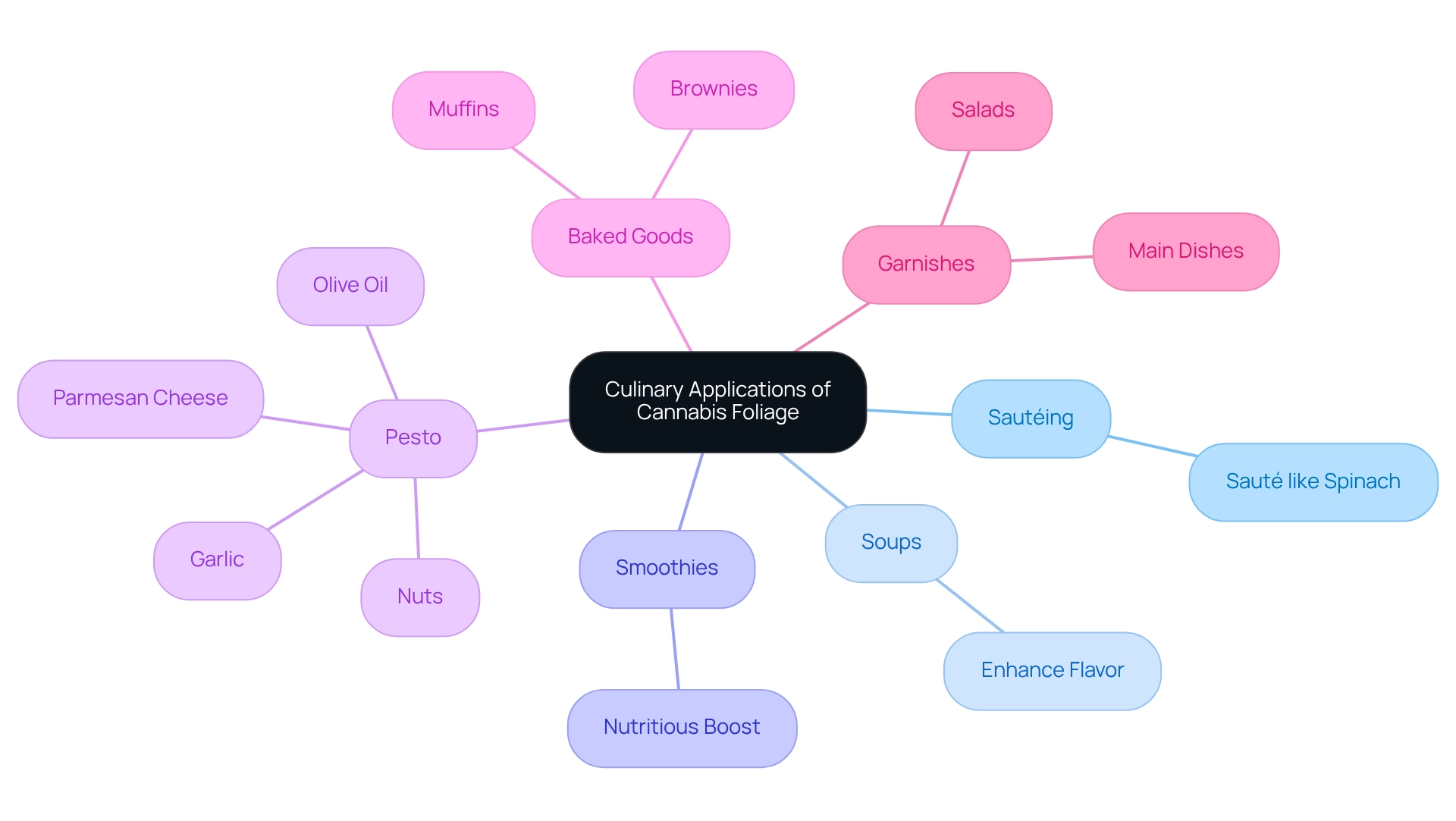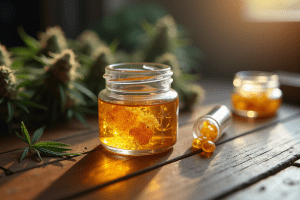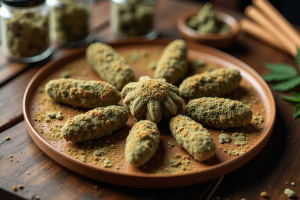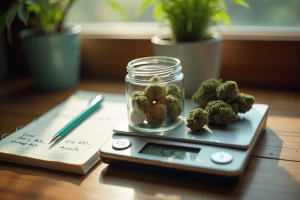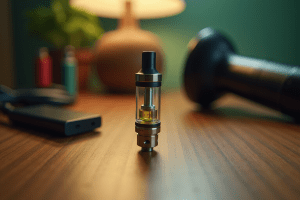Overview
This article serves as a comprehensive guide to the diverse uses of pot leaves, highlighting their culinary, medicinal, and creative applications for those new to cannabis. We understand that exploring cannabis can feel overwhelming, but pot leaves are both nutritious and versatile. They can enhance your meals, provide health benefits through their anti-inflammatory properties, and even serve as a medium for artistic expression. We encourage you to explore and utilize this often-overlooked part of the cannabis plant. Together, let’s discover the potential of pot leaves in your journey.
Introduction
In the world of cannabis, pot leaves often linger in the background, overshadowed by their more renowned counterparts, the flowers. Yet, these leaves are a treasure trove of potential, offering a diverse array of uses that can enrich our lives in many ways.
- Have you ever considered enhancing your smoothies or salads with their nutritional benefits?
- Or perhaps using them as a canvas for your artistic expression?
As we become more aware of their versatility, the conversation around cannabis is evolving, shedding light on the often-overlooked aspects of this remarkable plant. Together, let’s delve into the rich possibilities that pot leaves present, encouraging a deeper appreciation for their role in both our everyday lives and holistic health practices.
Exploring the Versatile Uses of Pot Leaves
The pot leaf, often overlooked, offers a wealth of applications that extend far beyond traditional consumption methods. It can be seamlessly integrated into our meals, used for medicinal purposes, or even transformed into beautiful artistic creations. By exploring these diverse applications, we can truly appreciate the benefits of this remarkable plant, including its potential for pain relief through topical CBD products and tinctures.
In the culinary world, pot leaf can enhance smoothies, salads, or be brewed into tea, adding nutritional value to our meals. For example, incorporating fresh pot leaf into a green smoothie not only boosts the health benefits of the beverage but also introduces a unique flavor. Many chefs are beginning to recognize the potential of pot leaf, embracing its use in a variety of dishes.
One chef shared, “Incorporating marijuana foliage in cooking not only adds a unique flavor but also offers various health advantages, making it a flexible component in any kitchen.”
On the medicinal front, pot leaf is gaining recognition for its healing properties. It can be utilized in tinctures, salves, or infused oils, providing potential relief for a range of ailments. Tinctures, in particular, offer fast-acting effects and precise dosing, allowing us to tailor our intake to our individual needs.
Research indicates that the antioxidant properties of pot leaf from marijuana, especially from strains like Bialobrzeskie and Tygra, can enhance our overall health and wellness. In fact, methanol extracts from these varieties have been noted for their strong antioxidant benefits, further supporting the claims about the health advantages of cannabis foliage in both culinary and medicinal contexts. This versatility is underscored by expert opinions that highlight the potential of pot leaf in holistic health practices.
Moreover, pot leaf can serve as a medium for creative expression. Projects like pressed foliage art or handmade paper not only showcase the visual beauty of pot leaf but also promote sustainability by utilizing every part of the plant. Additionally, the quality of marijuana foliage can be influenced by cultivation methods, as shown in studies examining cannabinoid and terpene potency in Cannabis sativa ‘Stillwater’ under different light treatments.
This multifaceted approach to pot leaf emphasizes its importance in both culinary and therapeutic realms, encouraging us to explore and embrace this often-neglected aspect of the herb. Furthermore, the role of efficient lighting technologies in marijuana cultivation is crucial, as lighting costs account for approximately 60% of total energy usage in indoor marijuana production. This highlights the significance of quality cultivation methods in maximizing the benefits of cannabis.
Nutritional and Medicinal Benefits of Pot Leaves
Cannabis foliage is truly a powerhouse of nutrition, brimming with essential vitamins and minerals such as Vitamin C, calcium, and iron. These leaves are also rich in antioxidants, which play a crucial role in combating oxidative stress in our bodies. Research shows that the antioxidant properties of marijuana foliage can significantly enhance overall health, with studies indicating their potential to improve nutritional quality when combined with other food ingredients, like extruded rice.
Looking ahead, by 2030, it’s expected that the number of individuals diagnosed with arthritis will rise to 67 million. This underscores the importance of marijuana’s anti-inflammatory properties for those living with this condition.
Medicinally, the cannabis leaf is recognized for its anti-inflammatory benefits, making it particularly advantageous for individuals suffering from chronic pain or inflammation. A statistical study of marijuana plant extracts, supported by the National Science Center in Poland, has uncovered a strong link between cannabinoid profiles and antioxidant activity. This research identifies specific extracts that showcase the most significant health benefits, highlighting the leaves’ role in promoting wellness without the mind-altering effects typically associated with other parts of the plant.
As Leafy Mate emphasizes, “What differentiates Leafy Mate from its competitors is its commitment to trust and transparency.” This statement reinforces the credibility of the information shared and showcases Leafy Mate’s dedication to educating consumers about the responsible use of cannabis products.
Incorporating cannabis foliage into your diet can be a simple yet effective way to boost your nutrient intake. Whether you add it to smoothies, salads, or cooked meals, these greens offer a natural source of health benefits, making them an excellent choice for anyone looking to enhance their overall wellness. Additionally, exploring Leafy Mate’s topical CBD products and herbal tinctures can further unlock the transformative potential of this plant for pain relief and improved well-being.
Don’t miss the chance to experience the benefits of Leafy Mate’s offerings—visit our website to learn more and embark on your journey towards better health today!
How to Prepare Pot Leaves for Consumption
Preparing pot leaf for consumption is a simple yet rewarding process that can significantly enhance your culinary experience while also tapping into the medical benefits of cannabis. Let’s start by rinsing the greens under cold water to remove any dirt or debris. This initial step is crucial for ensuring cleanliness and safety, allowing you to feel confident in your preparation.
If you’re considering adding the greens to your cooking, finely chopping them can truly enhance their taste and texture, enabling them to blend seamlessly into various dishes. Have you thought about how this could elevate your meals?
For those curious about creating cannabis-infused teas, soaking dried herbs in hot water for about 10 minutes can extract beneficial compounds, resulting in a soothing beverage that may help alleviate symptoms of chronic pain or nausea. When making cannabutter or oil, remember that decarboxylating the plant material is essential. This involves gently heating it at a low temperature, which activates the cannabinoids and terpenes, enhancing their effectiveness in your recipes.
As Youbin Zheng from the University of Guelph notes, understanding the decarboxylation process is key to optimizing the benefits of the pot leaf, especially for individuals seeking relief from ailments like epilepsy. It’s fascinating to see how knowledge can empower us in our culinary and health journeys.
Research shows that the potency of terpenes, such as myrcene and limonene, can increase with proper light exposure during the growth phase. This suggests that the quality of the foliage can significantly impact both their culinary applications and therapeutic effects. A study titled “Cannabinoid and Terpene Potency in Cannabis Inflorescences” found that while the dominant cannabinoid was cannabidiolic acid (CBDA), the potency of total terpenes increased linearly with higher light intensity. This underscores the importance of cultivation conditions in maximizing benefits.
Moreover, recent studies have highlighted the conventional applications of the plant’s foliage and seeds, emphasizing their potential in contemporary medicinal research. This historical context enriches our understanding and conversation about the advantages of pot leaf in modern usage. By following these optimal methods, you can truly enhance the benefits of cannabis foliage in your cooking and consumption, discovering their therapeutic potential while savoring a delightful culinary experience together.
Culinary Applications: Cooking with Pot Leaves
Cannabis foliage offers a versatile ingredient for various cooking applications, encouraging creativity in the kitchen. Have you ever thought about sautéing them like spinach, adding them to soups for a richer flavor, or blending them into smoothies for a nutritious boost? For a delightful twist on classic recipes, consider making pot pesto with fresh pot leaf: simply blend the greens with garlic, nuts, olive oil, and Parmesan cheese.
This unique sauce not only enhances pasta dishes but also serves as a flavorful spread. Alongside pesto, cannabis foliage can be a beautiful garnish for salads and main dishes, enhancing both visual appeal and adding a hint of herbal flavor. They can also be incorporated into baked goods, such as brownies or muffins, providing a subtle cannabis essence while enriching the overall nutritional profile of your meals.
The nutritional benefits of cannabis foliage are truly remarkable; they are rich in vitamins and minerals, making them a valuable addition to any meal. Cooking methods like blanching can help soften the greens and reduce bitterness, making them more enjoyable. As the cannabis-infused food market continues to grow, with forecasts indicating swift expansion due to changing consumer perspectives, the culinary possibilities of pot are gaining wider recognition.
A recent case study highlights this growth, showcasing the increasing interest from major companies in cannabis-infused foods. Chefs are exploring creative recipes that utilize marijuana foliage, demonstrating their versatility. Have you considered using cannabis plants in salads, stir-fries, or even as a unique ingredient in sauces? These applications highlight not only the plant’s flavor but also its health benefits, aligning with the growing trend of incorporating marijuana into everyday cooking.
As Margaret, a Certified Ganjier, wisely states, “Support your local bookseller,” reminding us of the importance of local resources in our culinary adventures. As more individuals seek to understand and incorporate pot leaf into their meals, the exploration of marijuana components in cooking is set to flourish. It’s essential to remember that the UK food safety authority (FSA) limits marijuana use to 70 mg per day, providing a guideline for safe consumption levels when cooking with pot leaf. This focus on education aligns with Leafy Mate’s mission to empower users with reliable information and promote responsible marijuana use, ensuring that new consumers can confidently explore culinary possibilities while prioritizing their health and safety.
Leafy Mate is dedicated to supporting its partners in the cannabis industry by enhancing brand recognition and offering savings opportunities, ensuring a trustworthy and enriching experience for everyone involved. Together, we can navigate this exciting culinary landscape and make informed choices that benefit our health and well-being.
Creative Uses: Crafting with Pot Leaves
Pot leaf foliage offers a multitude of opportunities for crafting, from pressed plant art to creative home decor items. Have you ever thought about how you can transform these leaves into something beautiful? To create stunning pressed plant art, start by selecting fresh pot leaves and placing them between two sheets of parchment paper. Press them under a heavy book for several days to ensure they dry properly.
Once dried, these plants can be beautifully framed or incorporated into scrapbooking projects, adding a unique touch to your creations. Imagine the joy of displaying your art, knowing you crafted it with care.
Alongside pressed plant art, pot leaves can be used in various DIY projects. For instance, they can be transformed into natural dyes, providing a vibrant and eco-friendly option for coloring fabrics. Another imaginative option is resin art, where dried plant materials, such as pot leaves, can be embedded in resin to create striking coasters, jewelry, or decorative items that honor marijuana culture. Isn’t it exciting to think about the possibilities?
The popularity of pressed leaf art has surged, reflecting a growing interest in sustainable and artistic expressions. Did you know that California has the highest number of dispensaries, totaling 3,659, which represents a quarter of all U.S. dispensaries? This enhances the availability of marijuana products to new buyers. Moreover, as Laura A. Bianchi, founding partner of Bianchi & Brandt, observes, “Others are entering into bad partnerships out of desperation, and we will likely see them in court in the future,” emphasizing the importance of trust and transparency in the industry.
Furthermore, comprehending the strength of marijuana is vital for novice users participating in marijuana crafting, as it improves their crafting experience and guarantees responsible use. The changing environment of marijuana acceptance is demonstrated by Slovenia’s recent authorization of home cultivation, reflecting a rising cultural importance of marijuana that resonates with many new users. By exploring these techniques, new users can interact with the plant in a creative and significant manner, fostering a deeper appreciation for its cultural importance.
For more comprehensive guidance on marijuana crafting and cultivation methods, we encourage you to consult the user manuals accessible through Leafy Mate. Together, we can explore valuable insights and resources that will support your journey into this rewarding craft.
Sustainability and Environmental Impact of Pot Leaf Usage
Using marijuana foliage plays a crucial role in enhancing sustainability in hemp cultivation. By reusing plant material that would typically be discarded, we can actively reduce waste and promote a more eco-friendly approach to marijuana use. For instance, composting pot leaf waste not only diverts organic material from landfills but also enriches the soil, enhancing nutrient availability for future plant growth. Isn’t it wonderful to think about how our small actions can contribute to a healthier planet?
This practice aligns with our broader goal of creating a circular economy in the marijuana sector, where every part of the pot leaf is valued and utilized. Together, we can make a difference.
The environmental impact of marijuana farming is an increasingly pressing issue. Research suggests that altering outdoor cultivation methods could potentially decrease emissions by as much as 76%. This significant reduction not only lowers the carbon footprint but also minimizes the use of harmful fertilizers and pesticides that can lead to water pollution. A case study examining the negative effects of illegal marijuana operations on water quality highlights the risks posed by chemical runoff from these farms, which can contaminate soil and water bodies, threatening both human health and the environment. By embracing sustainable methods, such as utilizing plant materials, we can help reduce these environmental challenges.
Moreover, repurposing hemp leaves can yield various eco-friendly products, from natural fertilizers to organic compost, further supporting sustainable agriculture. Experts emphasize the importance of integrating sustainability into marijuana cultivation, calling for the industry to adopt best practices that prioritize resource efficiency and waste reduction. As Kagia noted, “And we will have missed this window to build a portfolio of best practices that allow for an efficient, resource-minded, and minimally wasteful industry.”
Additionally, the marijuana industry faces challenges in recycling vape cartridges and batteries, which could become a significant waste issue as the sector continues to grow. Embracing these sustainable practices will be crucial in ensuring a responsible and environmentally conscious industry. Together, we can work towards a future that values both our health and the health of our planet.
Debunking Myths: FAQs About Pot Leaves
Many myths surround the use of cannabis foliage, often leading to confusion among new consumers. One common misconception is that cannabis foliage is merely waste and lacks genuine worth. In truth, the pot leaf is highly nutritious and can be utilized in various culinary and medicinal applications. Have you considered how these leaves might enhance your meals? For instance, they can be added to salads, smoothies, or teas, providing a rich source of vitamins and minerals.
Another widespread misunderstanding is the belief that plant leaves contain substantial amounts of THC, the psychoactive substance found in marijuana. However, plant foliage is primarily non-psychoactive, meaning it can be safely ingested without the intoxicating effects usually associated with marijuana blooms. This makes them a wonderful choice for those looking to explore cannabis without the high.
It’s essential to recognize that THC percentage is not the only factor influencing the effects felt from marijuana. The cannabinoid and terpene profiles play a more substantial role in shaping the overall experience. Understanding this can empower you to make more informed choices about your cannabis use.
Addressing these misunderstandings is vital for enabling consumers to make educated decisions about pot leaf. By providing precise information, Leafy Mate helps clarify the use of cannabis foliage, encouraging new users to confidently embrace its benefits. As of March 2024, with 24 states and the District of Columbia having legalized marijuana for both medical and recreational purposes, over half of Americans now reside in states where both varieties of the substance are permitted.
This evolving legal landscape reflects a growing acceptance of marijuana, underscoring the importance of understanding the full potential of cannabis—including its leaves. Moreover, approximately eight-in-ten Americans (79%) live in a county with at least one marijuana dispensary, highlighting the increasing accessibility of marijuana and its products. Have you explored the incredible relief offered by topical CBD products and herbal tinctures? These can enhance wellness and provide transformative benefits for those seeking natural remedies.
Leafy Mate is committed to transparency, education, and responsible use, making it your trusted resource for medical marijuana. With comprehensive services, 24/7 support, and a wealth of testimonials from satisfied customers, we invite you to discover the benefits of our offerings. Together, let’s explore how Leafy Mate can support your journey with marijuana today.
Where to Source Pot Leaves Responsibly
When sourcing cannabis, it’s essential to choose trustworthy suppliers to ensure both quality and legality. At Leafy Mate, we serve as your comprehensive resource for navigating the cannabis industry, connecting you to local dispensaries that prioritize sustainability and organic practices. Many of these establishments provide fresh pot leaf, allowing you to support ethical cultivation methods.
The dispensaries featured on Leafy Mate often share detailed information about their cultivation practices, fostering transparency and trust among consumers. Have you ever wondered about the origins of the products you consume? Staying informed about local regulations regarding marijuana cultivation and consumption is crucial for ensuring compliance with the law.
As Laura M. Dryburgh observes, “This review reveals that there is a lack of well‐designed scientific studies examining the pollutants of marijuana,” which emphasizes the necessity for quality control and product standardization as the marijuana industry continues to grow. With investments projected to exceed $100 billion globally by 2025, the focus on these aspects becomes increasingly vital.
By responsibly obtaining pot leaves through reliable suggestions from Leafy Mate, you not only enjoy the advantages of marijuana but also contribute to the advancement of ethical practices within the industry. This commitment to responsible sourcing aligns with the growing demand for transparency and trust in cannabis products, fostering a community of informed consumers. Together, we can make informed choices that benefit both ourselves and the industry.
Conclusion
Pot leaves are often overlooked in the cannabis conversation, yet their versatility and potential benefits are truly remarkable. Have you considered how these leaves can enhance your health and creativity? From culinary applications to medicinal uses, pot leaves can enrich our lives in many ways. Incorporating these leaves into meals—whether in salads, smoothies, or infused oils—introduces a wealth of nutrients and antioxidants that support overall wellness. Their anti-inflammatory properties are especially valuable for those experiencing chronic pain, making them a natural remedy worth exploring together.
Beyond the kitchen, pot leaves serve as a canvas for artistic expression, allowing us to craft unique projects that celebrate the plant’s beauty and significance. By using cannabis leaves sustainably, we promote environmental responsibility, reducing waste and fostering a circular economy within the cannabis industry. As we become more aware of the benefits and applications of pot leaves, we can actively contribute to a more sustainable future.
It’s essential to address common misconceptions about pot leaves to empower new cannabis consumers. By recognizing their nutritional value and understanding that they are primarily non-psychoactive, we can confidently incorporate pot leaves into our diets without fear of intoxication. As the cannabis landscape continues to evolve, the opportunity to explore the full potential of this remarkable plant grows as well. Embracing pot leaves not only enriches our personal health but also supports a more sustainable and informed cannabis culture. Together, let’s take the next step in our journey towards wellness and sustainability.
Frequently Asked Questions
What are the various applications of pot leaf?
Pot leaf can be integrated into meals, used for medicinal purposes, and transformed into artistic creations. It enhances culinary dishes, offers potential health benefits, and serves as a medium for creative expression.
How can pot leaf be used in cooking?
Pot leaf can enhance smoothies, salads, or be brewed into tea, adding nutritional value and a unique flavor to meals. Chefs are increasingly incorporating it into various dishes for its health advantages.
What medicinal uses does pot leaf have?
Pot leaf is recognized for its healing properties and can be utilized in tinctures, salves, and infused oils, providing potential relief for various ailments, particularly through its anti-inflammatory benefits.
What are the health benefits of pot leaf?
Pot leaf is rich in essential vitamins and minerals, such as Vitamin C, calcium, and iron, and contains antioxidants that combat oxidative stress. It has been linked to improved nutritional quality and offers anti-inflammatory benefits, making it advantageous for those with chronic pain or inflammation.
How does the quality of pot leaf affect its benefits?
The quality of marijuana foliage can be influenced by cultivation methods, with studies showing that different light treatments can affect cannabinoid and terpene potency, thereby impacting the health benefits of the plant.
What is the significance of efficient lighting in marijuana cultivation?
Efficient lighting technologies are crucial in marijuana cultivation, as lighting costs account for approximately 60% of total energy usage in indoor production. This highlights the importance of quality cultivation methods in maximizing the benefits of cannabis.
How can pot leaf contribute to sustainability?
Pot leaf can be used in projects like pressed foliage art or handmade paper, promoting sustainability by utilizing every part of the plant and showcasing its visual beauty.
What should consumers know about using cannabis products?
It is important for consumers to be educated about the responsible use of cannabis products, and companies like Leafy Mate emphasize trust and transparency in their offerings.
Get Your Medical Card
Connect with a licensed physician online in minutes


